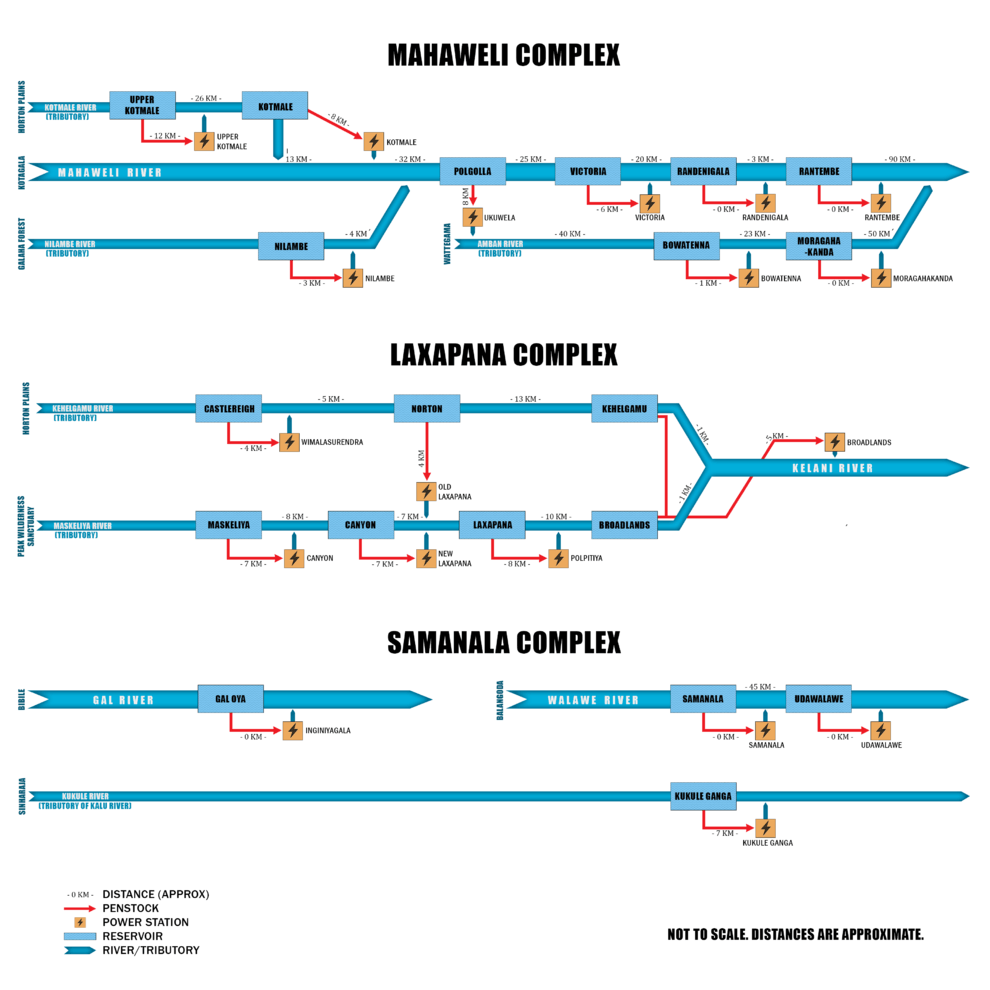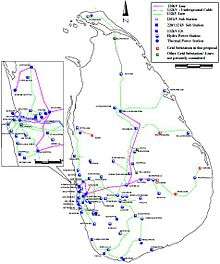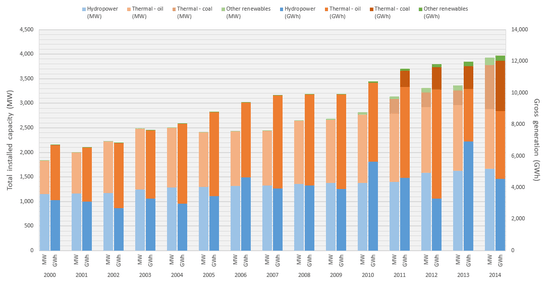Electricity sector in Sri Lanka
Electricity generation in Sri Lanka is primarily run by hydro power and thermal heat, with sources such as photovoltaics and wind power in early stages of deployment. Although potential sites are being identified, other power sources such as geothermal, nuclear, peat, solar thermal and wave power are not used in the power generation process for the national grid.[1]
Power generation

Electricity in Sri Lanka is generated using three primary sources — thermal power (which includes energy from biomass, coal, and all other fuel-oil sources), hydro power (including small hydro), and other non-conventional renewable energy sources (solar power and wind power):
| Source | 2005 | 2006 | 2007 | 2008 | 2009 | 2010 | 2011 | 2012 | 2013 | 2014 |
|---|---|---|---|---|---|---|---|---|---|---|
| Hydropower | 1,293 | 1,316 | 1,326 | 1,357 | 1,379 | 1,382 | 1,401 | 1,584 | 1,628 | 1,665 |
| Fuel oil | 1,115 | 1,115 | 1,115 | 1,285 | 1,290 | 1,390 | 1,390 | 1,338 | 1,335 | 1,215 |
| Coal | 0 | 0 | 0 | 0 | 0 | 0 | 300 | 300 | 300 | 900 |
| Other renewables | 3 | 3 | 3 | 3 | 15 | 45 | 50 | 90 | 99 | 152 |
| Total capacity | 2,411 | 2,434 | 2,444 | 2,645 | 2,684 | 2,817 | 3,141 | 3,312 | 3,362 | 3,932 |
| Source | 2005 | 2006 | 2007 | 2008 | 2009 | 2010 | 2011 | 2012 | 2013 | 2014 |
|---|---|---|---|---|---|---|---|---|---|---|
| Hydropower | 3,453 | 4,636 | 3,948 | 4,135 | 3,905 | 5,634 | 4,622 | 3,292 | 6,926 | 4,534 |
| Fuel oil | 5,314 | 4,751 | 5,865 | 5,763 | 5,975 | 4,994 | 5,748 | 6,935 | 3,303 | 4,306 |
| Coal | 0 | 0 | 0 | 0 | 0 | 0 | 1,038 | 1,404 | 1,469 | 3,202 |
| Other renewables | 2 | 2 | 2 | 3 | 27 | 86 | 121 | 171 | 262 | 315 |
| Total generation | 8,769 | 9,389 | 9,815 | 9,901 | 9,907 | 10,714 | 11,529 | 11,802 | 11,960 | 12,357 |
Hydroelectricity
Hydroelectricity is the oldest and historically the principal source of electricity generation in Sri Lanka, holding a share of 48% of the total available grid capacity in December 2013 and 58% of power generated in 2013.[4] Hydroelectric power generation has been constantly under development since the introduction of the national grid itself, but its market share is declining because suitable new sites are scarce. Currently, ten large hydroelectric power stations are in operation, with the single largest hydroelectric source being the Victoria Dam. Although a large portion of the country's hydroelectric resource are tapped, the government continues to issue small hydro development permits to the private sector, for projects up to a total installed capacity of 10 MW per project.[5]

State-run hydroelectric developments are categorized into three main geographic sectors.
- Laxapana Complex consists of six main dams with related power stations — Broadlands, Canyon, Castlereigh, Laxapana, Maskeliya, and Norton dams.
- Mahaweli Complex consists of eight dams and related power stations: Bowatenna, Kotmale, Moragahakanda, Polgolla, Randenigala, Rantembe, Upper Kotmale, and the Victoria dams.
- Samanala Complex consists of the Gal Oya, Kukule Ganga, Samanala, and Udawalawe dams.
Thermal power
Thermal power stations in Sri Lanka now roughly match the installed hydroelectric generation capacity, with a share of nearly 49% of the available capacity in December 2013 and 40% of power generated in 2013.[4] Thermal power stations in Sri Lanka runs on diesel, other fuel oils, naptha or coal.[4] The Norocholai Coal Power Station, the only coal-fired power station in the country, was commissioned in late 2011, adding a further 300 megawatts of electrical capacity to the grid. It is currently planned to add an additional 600 MW of capacity to Norocholai in the next half decade. The second and final coal power station,[6] the Sampur Coal Power Station, is under consideration in Trincomalee and is expected to be in-service by the end of 2017.[7]
Wind power

The use of wind energy was seen in the country even before 500 BC. The ancient Sinhalese used the monsoon winds to power furnaces as early as 300 BC, making Sri Lanka one of the first countries in the world to use wind power. Evidence of this has been found in Anuradhapura and in other cities.[8]
The development of modern wind farms has been considered by local and international developers for many years. Such developments were largely hampered due to the many obstacles faced in such developments in economics and infrastructure. The first commercial grid-connected wind farm is the 3 MW Hambantota Wind Farm, northwest of Hambantota.
Unlike other power sources, power developments from this source would face many challenges during its development timeline. Poor accessibility to potential sites is the first obstacle in the development of a wind farm. Most key transport routes around the country are too narrow or is constructed with tight turns to support transportation of turbines larger than 600 KW. Constructing wind farms with turbines smaller than the current commercial-scale megawatt-class turbines would prove to be uneconomical due to the high cost incurred during development.
The country is also in a long battle against its poor power grid. The grid, apart from being unstable in most provinces, is only capable of handling a small increases in load, typically limited to a few megawatts. Provinces with poor grids, such as the power grids in the Northern, North Central and North Western provinces needs complete upgrade to support further commercial-scale developments. This factor contributes to a large percentage in development costs for wind farms constructed such locations. The government policy limit of 10 MW per wind project also significantly decreases economies-of-scale, further straining such developments.
Current status
Despite the many technical obstacles, a few developments totaling 50 MW have been proposed till September 2009.[9] In October 2009, cases were filed over political interference connected with the approving of wind projects, leading to a complete halt in the wind power industry in Sri Lanka.[10] The Ministry made allegations of wrongdoing in allocating energy licences, including the structuring of the wind power tariff.[11] There were also allegations that energy licenses are being sold, similar to how car licenses have been sold.[11]
From December 2009 to March 2010, permits for another 50 MW of projects were issued by the Sri Lanka Sustainable Energy Authority, before concerns relating to the issuing of permits were raised again,[12][13] leading to another deadlock in the industry. As of June 2010, issuing of permits for the development of private wind farms were stopped.
In July 2010, engineers at the Ceylon Electricity Board raised further concerns regarding the approval of private wind projects with extra high tariffs, presumably some of the highest in the world.[14] A review of the wind power tariff was expected to be carried out on 12 September 2010,[15] after an agreed postponement.[16]
Solar power
Grid-connected solar power has only recently been introduced. The only operational commercial-scale solar-powered facility is the Buruthakanda Solar Park of 1.2 MW, operated by the Sri Lanka Sustainable Energy Authority (SLSEA).[17]
Geothermal power
Geothermal power is under research, although no power stations of this type are operational.[18][19][20]
Nuclear power
The CEB has included a 600MWe nuclear power plant as an option in its plans for 2031.[21]
Power transmission
Transmission network
The Sri Lankan electric transmission network consists principally of 132kV facilities, with a 220kV backbone connecting major inland hydroelectric generation to the capital region.

| Line | No. of Ground Wires | No. of circuits | Nominal Voltage |
|---|---|---|---|
| Kolonnawa-Athurugiriya | 2 | 2 | 132kV |
| Pannipitiya-Ratmalana | 2 | 2 | 132kV |
| Biyagama-Pannipitiya | 2 | 2 | 220kV |
| Biyagama-Kotmale | 2 | 2 | 220kV |
| Kothmale-Kiribathkumbura | 2 | 2 | 132kV |
| Kiribathkumbura-Ukuwela | 2 | 2 | 132kV |
| Kiribathkumbura-Kurunagala | 1 | 2 | 132kV |
| Puttalam-Madampa | 1 | 2 | 132kV |
| Ukuwela-Bowatanna | 1 | 1 | 132kV |
| Ukuwela-Naula | 2 | 2 | 132kV |
| Naula-Habarana | 2 | 2 | 132kV |
| Habarana-Old Anuradhapura | 1 | 2 | 132kV |
| Old Anuradhapura-Puttalam | 2 | 2 | 132kV |
| New Laxapana-Bogawanthalawa Estate | 1 | 2 | 132kV |
| New Anuradhapura-Vavuni | 1 | 2 | 132kV |
| Embilipitiya-Thimbolketiya | 2 | 2 | 132kV |
| New Laxapana-Canyon PS | 2 | 1 | 132kV |
| Old Laxapana-Polpitiya | 2 | 2 | 132kV |
| Kotmale-Polpitiya | 2 | 2 | 132kV |
| Nuwara Eliya-Badulla | 2 | 2 | 132kV |
| Old Laxapana-Nuwara Eliya | 2 | 2 | 132kV |
| Badulla-Medagama | 2 | 1 | 132kV |
| Polpitiya-Seethawake | 2 | 2 | 132kV |
| Seethawake-Kosgama | 2 | 2 | 132kV |
| Athurugiriya-Thulhiriya | 2 | 2 | 132kV |
| Embilipitiya-Hambantota | 2 | 2 | 132kV |
| Balangoda-Samanalawewa | 2 | 2 | 132kV |
| Balangoda-Rathnapura | 2 | 2 | 132kV |
| Balangoda-Deniyaya | 1 | 2 | 132kV |
| Matara-Embilipitiya | 2 | 2 | 132kV |
| Habarana-Valachchenai | 1 | 1 | 132kV |
| Kelanitissa-Biyagama | 2 | 2 | 220kV |
India – Sri Lanka grid interconnection
The connection involves the linking of the national grids of India and Sri Lanka via Rameshwaram in south India and Talaimannar in north-west Sri Lanka. The project involves the construction of a HVDC connection between Madurai in southern India and Anuradhapura in central Sri Lanka, through the Palk Strait. The link would measure approximately 285 kilometres (177 mi) in length, including 50 kilometres (31 mi) of submarine cables, and would take more than three years to construct. It would be implemented by the Power Grid Corporation of India Limited and Ceylon Electricity Board.[22]
Electricity use
End-user power tariffs
The monthly end-user electricity tariffs effective from 20 April 2013 are as follows:
| User | Unit (kWh)/Time range | Tariff (Rs./kWh) | Fixed Charge (Rs./month) | Fuel Adjustment Charge (% of Total Energy Charge) | Max. Demand Charge (Rs./kVA) |
|---|---|---|---|---|---|
| Domestic (D-1) (If the consumption is between 0-60 kWh per month) | 000-030 | 3.00 | 30.00 | 25 | N/A |
| 031-060 | 4.70 | 60.00 | 35 | ||
| Domestic (D-1) (If the consumption is above 60 kWh per month) | 000-060 | 10.00 | N/A | N/A | N/A |
| 061-090 | 12.00 | 90.00 | 10 | ||
| 091-120 | 26.50 | 315.00 | 40 | ||
| 121-180 | 30.50 | ||||
| ≥181 | 42.00 | 420.00 | |||
| Religious (R-1) | 000-030 | 1.90 | 30.00 | N/A | N/A |
| 031-090 | 2.80 | 60.00 | |||
| 091-120 | 6.75 | 180.00 | |||
| 121-180 | 7.50 | 180.00 | |||
| ≥181 | 9.40 | 240.00 | |||
| General Purpose (GP) | GP-1: ≤210 | 19.50 | 240.00 | 25 | N/A |
| GP-1: ≥211 | 21.50 | ||||
| GP-2: Day (05:30-18:30) | 20.50 | 3,000.00 | 1,100 | ||
| GP-2: Peak (18:30-22:30) | 25.00 | ||||
| GP-2: Off-peak (22:30-05:30) | 14.50 | ||||
| GP-3: Day (05:30-18:30) | 19.50 | 1,000 | |||
| GP-3: Peak (18:30-22:30) | 24.00 | ||||
| GP-3: Off-peak (22:30-05:30) | 13.50 | ||||
| Government (GV) [Note 1] | GV-1: ∞ | 14.65 | 600.00 | 0 or 25 | N/A |
| GV-2: ∞ | 14.55 | 3,000.00 | 1,100 | ||
| GV-3: ∞ | 14.35 | 1,000 | |||
| Hotel (H) | H-1: ∞ | 22.00 | 600.00 | 15 | N/A |
| H-2: Day (05:30-18:30) | 14.65 | 3,000.00 | 1,100 | ||
| H-2: Peak (18:30-22:30) | 23.50 | ||||
| H-2: Off-peak (22:30-05:30) | 09.80 | ||||
| H-3: Day (05:30-18:30) | 12.60 | 1,000 | |||
| H-3: Peak (18:30-22:30) | 16.40 | ||||
| H-3: Off-peak (22:30-05:30) | 8.85 | ||||
| Industry (I) | I-1: ∞ | 12.50 | 600.00 | 15 | N/A |
| I-2: Day (05:30-18:30) | 11.30 | 3,000.00 | 1,100 | ||
| I-2: Peak (18:30-22:30) | 21.00 | ||||
| I-2: Off-peak (22:30-05:30) | 7.00 | ||||
| I-3: Day (05:30-18:30) | 10.50 | 1,000 | |||
| I-3: Peak (18:30-22:30) | 24.00 | ||||
| I-3: Off-peak (22:30-05:30) | 6.00 | ||||
| Street Lighting | ∞ | 17.00 | N/A | ||
Net metering
In July 2010, the Ministry of Power and Energy, with the Lanka Electricity Company and the Ceylon Electricity Board introduced net metering, where consumers could generate their own power from renewable sources and credit excess production back to the power utility.[24] While the power utility will not pay back in monetary values irrespective of how much credit a household generates, it allows the transferring of this credit between households.[25] The first solar power facility intended for net metering was commissioned in July 2010.[26]
Entities exempted for electricity-usage charges
Per Section 21-2 of the Sri Lanka Electricity Act No. 20 of 2009,[27] the Public Utilities Commission of Sri Lanka has granted the following entities exemptions in electricity usage:
| Exemption No. | Person/Entity | Premises | Gazette No. & Date |
|---|---|---|---|
| EL/EX-D/11/001 | MAS Fabric Park (Private) Limited | MAS Fabric Park, Kurunegala Road, Thulhiriya | Extraordinary Gazette – No. 1725/14 28 September 2011 |
| EL/EX-D/11/002 | Overseas Realty (Ceylon) PLC | World Trade Centre, Echelon Square, Colombo 1 | |
| EL/EX-D/11/003 | Mireka Capital Land (Private) Limited | 324, Havelock Road, Colombo 6 | |
| EL/EX-D/12/001 | Asian Hotels and Properties PLC | No. 89, Galle Road, Colombo 3 | General Gazette – No. 1744, 3 February 2012 |
| EL/EX-D/12/002 | BOC Property Development & Management (Private) Limited | BOC Merchant Tower, 28, St. Michael’s Road, Colombo 3 | |
| EL/EX-D/12/003 | Millenium Development (Private) Limited | Excel World Entertainment Park, 338, T B Jayah Mawatha, Colombo – 10 | |
| EL/EX-D/12/004 | Property Finance and Investments Kandy (Private) Limited | Kandy City Centre, 05, Dalada Vidiya, Kandy | |
| EL/EX-D/12/005 | Whittall Boustead (Private) Limited | 148, Vauxhall Street, Colombo 2 | |
| EL/EX-D/12/006 | Ceylon Carriers (Private) Limited | 104, Nawala Road, Narahenpita, Colombo 5 | Extraordinary Gazette – No. 1749/8, 12 March 2012 |
| EL/EX-D/12/007 | JayKay Marketing Services (Private) Limited | K-Zone Shopping Mall, 340, Galle Road, Moratuwa | Extraordinary Gazette – No. 1757/19, 11 May 2012 |
| EL/EX-D/12/008 | Platinum Realty Investments (Private) Limited | 01, Bagatale Road, Colombo 3 | |
| EL/EX-D/12/009 | Union Residencies (Private) Limited | No. 200, Union Place, Colombo 2 | |
| EL/EX-D/12/010 | Pelwatte Sugar Industries PLC | Pelwatte Sugar Industries Buttala | |
| EL/EX-G/12/001 | Tokyo Cement Power (Lanka) Limited | 10 MW Biomass Power Plant, Cod Bay, China Bay, Trincomalee | Extraordinary Gazette – No. 1759/31, 23 May 2012 |
See also
References and Notes
Notes
- ↑ Schools, hospitals, vocational training institutions and universities included, which are fully owned by the government, funded through the national budget, and providing services free-of-charge to the general public. Hospitals and schools are exempted from the Fuel Adjustment Charge (FAC).
References
- 1 2 CEB Statistics, retrieved 2012-10-07
- ↑ Economic and Social Statistics of Sri Lanka 2011 pg. 58
- ↑ Economic and Social Statistics of Sri Lanka 2012 pg. 58
- 1 2 3 Ceylon Electricity Board Statistical Digest 2013
- ↑ Energy permits for small hydro projects, retrieved 2012-10-07
- ↑ No more coal plants, retrieved 2010-08-08
- ↑ Ministry: Current energy projects (PDF), retrieved 2010-08-07
- ↑ G. Juleff, "An ancient wind powered iron smelting technology in Sri Lanka", Nature 379(3), 60–63 (January, 1996)
- ↑ Energy permits for wind projects (PDF), retrieved 2010-10-22
- ↑ Sri Lanka wind power probe to finish soon, retrieved 2010-08-07
- 1 2 Wind powered electricity generation projects halted, retrieved 2010-09-12
- ↑ Uproar over wind power scheme, retrieved 2010-08-07
- ↑ SLSEA rejects CEB engineers’ concerns, retrieved 2010-08-07
- ↑ CEB to purchase wind power at world’s highest price, retrieved 2010-08-07
- ↑ Revision of Non-Conventional Renewable Energy Based Electricity Purchase Tariffs, retrieved 2010-09-12
- ↑ Extension of Period allowed for representations on proposed Non-Conventional Renewable Energy Based Electricity Purchase Tariffs, retrieved 2010-09-12
- ↑ Energy permits for solar projects (PDF), retrieved 2010-10-22
- ↑ Sri Lanka is to develop geothermal power, retrieved 2010-08-07
- ↑ Geothermal energy in Sri Lanka, retrieved 2010-08-07
- ↑ Geothermal energy for growing power demand, retrieved 2010-08-07
- ↑ "Sri Lanka eyes nuclear power plant after 2030". Lanka Business Online. 4 Jun 2014. Retrieved 12 January 2015.
- ↑ "India-Sri Lanka 285-Km Power Transmission Link By 2013". RTT News. Global Energy Network Institute. 2009-12-29. Retrieved 2010-03-08.
- ↑ "Electricity Tariffs for 2013" (PDF). Public Utilities Commission of Sri Lanka. May 2013. Retrieved 9 May 2013.
- ↑ Sri Lanka power utility to start net metering, retrieved 2010-08-07
- ↑ Net metering of electricity, retrieved 2010-08-07
- ↑ Sri Lanka gets first ever net metered solar photovoltaic plant, retrieved 2010-08-07
- ↑ "Sri Lanka Electricity Act No. 20 of 2009" (PDF). Parliament of the Democratic Socialist Republic of Sri Lanka. 8 April 2009. Retrieved 21 April 2013.
- ↑ "Electricity Exemptions Granted to Persons as per the Section 21 (2) of the Sri Lanka Electricity Act No. 20 of 2009" (PDF). Public Utilities Commission of Sri Lanka. 1 April 2000. Retrieved 21 April 2013.

